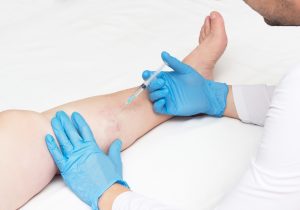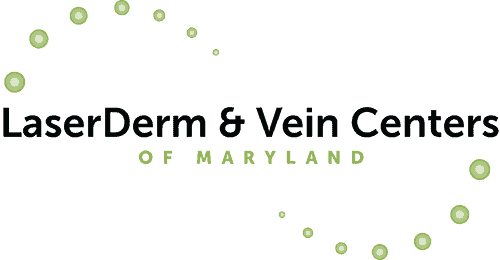 Varicose Veins and Spider Veins affect an estimated 40% of women and a smaller – but, significant, number of men. For some the problem is simply their unsightly appearance but others experience symptoms associated with these dilated veins. Fortunately, most of these unwanted veins – including large Varicose Veins – can be removed non-surgically by Sclerotherapy.
Varicose Veins and Spider Veins affect an estimated 40% of women and a smaller – but, significant, number of men. For some the problem is simply their unsightly appearance but others experience symptoms associated with these dilated veins. Fortunately, most of these unwanted veins – including large Varicose Veins – can be removed non-surgically by Sclerotherapy.
What is Sclerotherapy?
Sclerotherapy is the most consistently effective non-surgical procedure to eradicate unwanted, non-functional Varicose Veins and Spider Veins. Although used primarily to remove veins of the legs and thighs, unwanted veins at other sites – including facial veins and prominent veins of the hands and feet – can also be treated by Sclerotherapy
How is Sclerotherapy performed?
Using a very small needle, a sterile solution (called a sclerosant) is injected into the vein. The purpose of the solution is to produce irreversible alteration to the vein wall. If this is achieved, the vein will be absorbed, weeks to months after treatment, as is illustrated below.
Is there any harm in removing these unsightly veins?
No. Varicose Veins and Spider Veins are non-functional and their removal does not adversely affect circulation.
Does the removal of Varicose and Spider Veins by Sclerotherapy result in the appearance of new veins?
No. The removal of Varicose Veins and Spider Veins does not stimulate the development of new veins. By the time Varicose Veins and Spider Veins have appeared, normal veins, in the same vicinity, have taken over their function without the need for the body to develop new veins in response to their removal. However, anyone who has Varicose Veins and Spider Veins is predisposed to this condition and new Varicose Veins and Spider Veins may develop, whether or not pre-existing veins have ever been treated.
Can anyone be treated?
With few exceptions, almost anyone with unwanted Varicose Veins and Spider Veins can be treated by Sclerotherapy. Women who are pregnant or nursing are not treated – treatment is postponed until after delivery and lactation are completed.
What can I expect after Sclerotherapy?
Usually mild redness, swelling, and tenderness appear along the course of the treated veins. These symptoms may persist for days, weeks to months depending upon the size and location of the treated veins. Less commonly, there may be some bruising. After Sclerotherapy, the vein may feel firm within the skin until it has been completely absorbed – this can take weeks to months, depending upon the size of the vein.
Are there restrictions after Sclerotherapy?
No. After Sclerotherapy all normal activities may be resumed, without any limitations. Compression hosiery may be required, for one to a few weeks after Sclerotherapy.
How many Sclerotherapy treatments are required?
The number of treatments required depends upon the number and extent of unwanted veins. Usually a vein will respond after one treatment. However, because there is a limit to the quantity of sclerosant that can be administered during any one treatment, if there are numerous veins present, several treatments may be necessary. If more than one treatment session is required, they can be scheduled at intervals of 24 hours.
Should I wait until after I have all of my pregnancies before treating my veins?
No, this is a common misconception. There is no need to wait until after all of your anticipated pregnancies to begin Sclerotherapy. In fact, it is wise to treat Varicose Veins and Spider Veins prior to pregnancy; otherwise, they usually become more apparent and more symptomatic as pregnancy progresses.
Are there any side effects associated with Sclerotherapy?
Sclerotherapy, as with any medical intervention, has the potential for unwanted side effects. Fortunately, serious side effects from Sclerotherapy are rare. The most common change associated with Sclerotherapy is temporary discoloration along the course of the treated vein. It appears as a tan or brown line and should be expected in almost everyone who is treated with Sclerotherapy. It disappears spontaneously after a few months or longer. Less commonly, Dilated Capillaries or redness can develop adjacent to treated Spider Veins. These usually fade spontaneously and only uncommonly persist. A rare complication is the development of an erosion or ulcer at a treatment site, which can take weeks to months to heal, often resulting in a scar.
Is Endovenous Ablation an option instead of Sclerotherapy?
Usually not. Endovenous Ablation is reserved for treatment of the Saphenous veins. The Saphenous veins are usually not visible and are examined through duplex ultrasound examination. Most prominent, visible and palpable Varicose Veins are branches of the Saphenous veins and are best treated by Sclerotherapy. For more information about Endovenous Ablation click here.
Photo Gallery of Sclerotherapy
Leg Veins
Feet & Ankle Veins
Facial Veins
Hand Veins
OUR OFFICE IS COMPLIANT WITH THE CURRENT MARYLAND REGULATIONS INCLUDING: 10.32.09: Delegation and Assignment of Performance of Cosmetic Medical Procedures and Use of Cosmetic Medical Devices. This is a Maryland safety regulation that governs who can legally perform medical cosmetic procedures. Dr. Green administers all injectable treatments (including Botox™, Juvederm™, Voluma™, Kybella™, and other fillers & Sclerotherapy) and laser treatments.
Sign up for monthly promotions and office updates!
By submitting this form, you are consenting to receive marketing emails from: David Green M.D. and LaserDerm & Vein Centers of Maryland, 4800 Montgomery Lane L50, Bethesda, MD, 20814, US, http://www.laserderm.net. You can revoke your consent to receive emails at any time by using the SafeUnsubscribe® link, found at the bottom of every email. Emails are serviced by Constant Contact.
Have Questions & Want More Information?
- Copyright © 2024 LaserDerm Vein Centers of Maryland
- Web Development by NavaWeb
